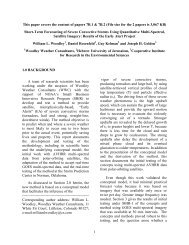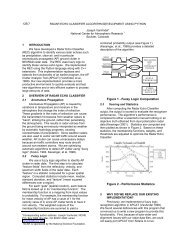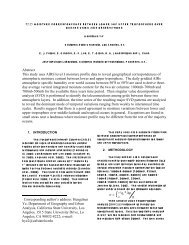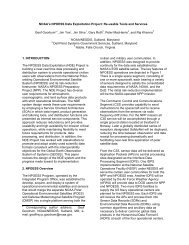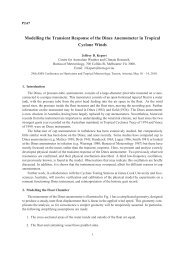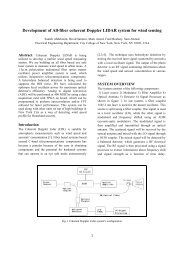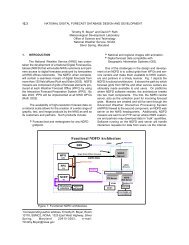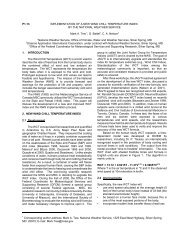J6.9 CLIMATOLOGY OF SOUTH AMERICAN COLD FRONTS ...
J6.9 CLIMATOLOGY OF SOUTH AMERICAN COLD FRONTS ...
J6.9 CLIMATOLOGY OF SOUTH AMERICAN COLD FRONTS ...
Create successful ePaper yourself
Turn your PDF publications into a flip-book with our unique Google optimized e-Paper software.
<strong>J6.9</strong> <strong>CLIMATOLOGY</strong> <strong>OF</strong> <strong>SOUTH</strong> <strong>AMERICAN</strong> <strong>COLD</strong> <strong>FRONTS</strong><br />
1. INTRODUCTION<br />
Frontal systems affect the weather over South<br />
America during all seasons of the year. They are easily<br />
visualized in satellite images as they advance from<br />
southwest to northeast over the continent. In this study,<br />
NCEP/NCAR reanalysis data are used to compute the<br />
climatology of cold fronts over South America during the<br />
period of 1979 to 2000, and to determine the associated<br />
atmospheric circulation features. The analysis is<br />
performed seasonally and monthly, using combined<br />
criteria for temperature, pressure and wind. Possible<br />
frost cases are identified and the main atmospheric<br />
characteristics and evolution are discussed.<br />
2. METHODOLOGY<br />
To identify significant cold frontal passages over<br />
South America we used the following criteria applied at<br />
each grid point in the daily-averaged reanalysis data: 1)<br />
a 925-hPa temperature decrease of at least 2C, 2) a<br />
rise in sea level pressure of at least 2 hPa, and 3) a<br />
southerly wind of at least 2 m s -1 .<br />
Possible frost cases are determined using the 2-meter<br />
minimum temperature (T2mmin), taken from the<br />
reanalysis archive. If T2mmin is less than 3 0 C at a grid<br />
point, frost (freeze) is assumed to have occurred.<br />
3. RESULTS<br />
3.1 Climatology of frontal passages<br />
The results show two main tracks for frontal systems<br />
over the continent, one in the interior, extending from<br />
northern Argentina northward to the western Amazon<br />
region and the other one along the east coast of Brazil<br />
(Fig. 1). On average, one or two cold fronts cross the<br />
equator in the western Amazon each winter. For most<br />
regions the number of frontal passages is a maximum in<br />
winter-early spring (June-October) and a minimum in<br />
January and February (Fig. 2).<br />
_____________________________________<br />
* Corresponding author address: Iracema F. A.<br />
Cavalcanti, CPTEC/INPE, Cachoeira Paulista, SP,<br />
Brazil; e-mail: iracema@cptec.inpe.br.<br />
Iracema F. A. Cavalcanti<br />
CPTEC/INPE, Cachoeira Paulista, SP, Brazil<br />
And<br />
Vernon E. Kousky<br />
NOAA/NCEP/CPC, Camp Springs, MD<br />
FIG. 1. Mean (1979-2000) number of cold frontal<br />
passages, which satisfy the criteria given in the text.<br />
3.2 Climatology of frost/freeze events<br />
The main features associated with potential frost<br />
cases are an amplified wave pattern with a ridge over<br />
the eastern Pacific and a trough over the Atlantic and<br />
southern Brazil. At the surface, a strong high-pressure<br />
system crosses the Andes favoring northward flow of<br />
cold air over subtropical South America, which<br />
sometimes reaches as far north as the equator.<br />
Composites of cases over South America show that the<br />
ridge/trough pattern is part of a wavetrain, which<br />
extends from the western South Pacific eastward to<br />
South America and can be identified as much as 4 days<br />
prior to the cold air outbreak over South America (Fig.<br />
3). Time-longitude sections of 500 hPa geopotential<br />
anomalies indicate Rossby wave propagation and<br />
energy dispersion, that at times link cases of cold fronts<br />
over South America to later occurrences of cold air<br />
incursions over southern Africa (Fig. 4).
FIG. 2. Mean annual cycle of frontal passages for the<br />
regions depicted in the figure.<br />
FIG. 3. Composite 500-hPa height anomaly patterns for<br />
lead times up to 5 days (t-5) prior to significant cold<br />
frontal passages (t) over southern Brazil.<br />
FIG. 4. Time-longitude section of 500-hPa height<br />
anomalies at 40S for the period 20 June-5 July 1994.<br />
Contour interval is 60 m. Negative anomalies are<br />
indicated by dashed contours. The base period for<br />
computing anomalies is 1979-1995. The two black<br />
circles indicate the onset of cold air outbreaks over<br />
subtropical South America (24 June) and southern<br />
Africa (28 June), respectively. Phase propagation of the<br />
waves (about 8 degrees of longitude per day) is<br />
indicated by the thin dashed line. Energy propagation<br />
(about 38 degrees of longitude per day) is indicated by<br />
the heavy dotted line.<br />
4. CONCLUSION<br />
The climatology of frontal systems over South<br />
America, from 1979 to 2000, is obtained using<br />
NCEP/NCAR reanalysis data. The results show several<br />
characteristics observed in satellite images, such as<br />
frontal systems following two main tracks, one in the<br />
interior, from northern Argentina to Amazon region, and<br />
other along the east coast of Brazil. There is a seasonal<br />
variability in the frequency of cold fronts, with a<br />
maximum in the winter, early spring and a minimum in<br />
the summer. Cold air outbreaks are associated with an<br />
amplified ridge/trough, which is part of a wavetrain from<br />
the Southern Pacific to South America. This pattern can<br />
be detected four days prior to the day of occurrence.<br />
Strong cold air outbreaks over South America are<br />
sometime followed by similar events over southern<br />
Africa.<br />
Acknowledgments: We are grateful to IAI/ PROSUL/<br />
CRN055 and CNPq for the support of the research<br />
and FAPESP for the travel support.



